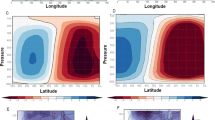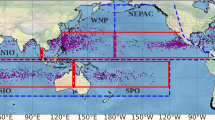Abstract
The clouds’ macro-, microphysical vertical structures and radiative effects in 4 shear-relative quadrants of typhoon over the northwest Pacific during development, maturity and extinction stages are studied based on CloudSat Tropical Cyclone dataset and China Meteorological Administration tropical cyclone dataset from 2nd June 2006 to 31th December 2015. The typhoon cloud is in an asymmetric “mushroom” shape, with the downshear quadrants (in particular of the downshear left quadrant (DL)) have denser clouds than the upshear quadrants. Cloud ice water content mainly distributes near typhoon center with wide vertical range (6–17 km). A large number of ice particles with small sizes are gathering in high levels, while small amount of ice particles with large sizes are gathering in low levels. As typhoon matures, the number concentration and size of cloud ice particles in inner ring increases, especially in the DL quadrant; while in the upshear left (UL) quadrant, a larger amount of ice particles with bigger sizes are transport to high levels (above 16 km) by deeper convection near storm center. The shortwave (longwave) cloud radiative effects (CRE) is mainly heating (cooling) upper layer atmosphere between 10 km and 17 km (between 14 km and 17 km), and the net CRE on atmosphere is heating almost at any levels in typhoon. The strongest heating of shortwave CRE and net CRE, as well as the strongest cooling of longwave CRE are in the DL quadrant at development stage and in the UL quadrant at maturity stage in inner core of storms. The existences of typhoon clouds mainly decrease solar radiation penetrating to the earth surface and increase longwave radiation absorbed by the whole atmosphere in typhoon’s inner core, and they are generally stronger in downshear (especially in DL) quadrants, except the maturity stage when the UL quadrant performs the strongest shortwave CRE on the surface and longwave CRE on the atmosphere in typhoon’s inner core.














Similar content being viewed by others
References
Austin, R.: Level 2B Radar-Only Cloud Water Content (2B-CWC-RO) Process Description Document. CloudSat Project Report,. Can be downloaded from http://www.cloudsat.cira.colostate.edu/data-products/level-2b/2b-cwc-ro?term=28 (2007). Accessed 23 April 2019
Camp, J.P., Montgomery, M.T.: Hurricane maximum intensity: past and present. Mon. Weather Rev. 129, 1704–1717 (2001)
Chan, K.T.F., Chan, J.C.L., Wong, W.K.: Rainfall asymmetries of landfalling tropical cyclones along the South China coast. Meteorol. Appl. 26, 213–220 (2019). https://doi.org/10.1002/met.1754
Chen, S., Li, W., Lu, Y., Wen, Z.: Variations of latent heat flux during tropical cyclones over the South China Sea. Meteorol. Appl. 21, 717–723 (2013). https://doi.org/10.1002/met.1398
Chou, K.-H., Lin, S.-J., Ciang, M.-H.: The study of vertical wind shear induced convection asymmetry of tropical cyclone by CMORPH satellite data. Atmos. Sci. 44, 353–376 (2016)
Chou, K.-H., Yeh, C.-M., Lin, S.-J.: The roles of vertical wind shear and topography in formation of convective asymmetries in Typhoon Nanmadol (2011). Terr. Atmos. Ocean. Sci. 30, 185–214 (2019). https://doi.org/10.3319/TAO.2018.12.16.01
Copernicus Climate Change Service (C3S): ERA5: Fifth generation of ECMWF atmospheric reanalyses of the global climate. Copernicus Climate Change Service Climate Data Store (CDS), last accessed in 3rd Sep. 2019. https://cds.climate.copernicus.eu/cdsapp#!/home (2017). Accessed 28 July 2019
DeHart, J.C., Houze, J.R.A., Rogers, R.F.: Quadrant distribution of tropical cyclone inner-core kinematics in relation to environmental shear. J. Atmos. Sci. 71, 2713–2732 (2014)
Durden, S.L., Tanelli, S., Dobrowalski, G.: CloudSat and A-Train observations of tropical cyclones. Open Atmos. Sci. J. 3(1), 80–92 (2009)
Elsberry, R.L.: Advances in research and forecasting of tropical cyclones from 1963–2013. Asia-Pacific J. Atmos. Sci. 50(1), 3–16 (2014). https://doi.org/10.1007/s13143-014-0001-1
Han, D., Yan, W., Ye, J., Liu, H.: Analyzing cloud, precipitation, and thermal structure characteristics of typhoons in eastern Pacific based on CloudSat satellite data. Chinese J. Atmos. Sci. 37(3), 691–704 (2013) (in Chinese)
Hence, D.A., Houze, J.R.A.: Vertical structure of hurricane eyewalls as seen by the TRMM precipitation radar. J. Atmos. Sci. 68, 1637–1652 (2011). https://doi.org/10.1175/2011JAS3578.1
Henderson, D., Ecuyer, T. L., Vane, D., Stephens, G., Reinke, D.: Level 2B fluxes and heating rates and 2B fluxes and heating rates w/Lidar process description and interface control document (Version 1.0). CloudSat Project Report,. Can be downloaded from http://www.cloudsat.cira.colostate.edu/data-products/level-2b/2b-flxhr-lidar?term=38 (2011). Accessed 23 April 2019
Heymsfield, A.J., Protat, A., Austin, R.T., Bouniol, D., Hogan, R.J., Delanoe, J., Okamoto, H., Sato, K., Zadelhoff, J.G., Donovan, D.P., Wang, Z.: Testing IWC retrieval methods using radar and ancillary measurements with in situ data. J. Appl. Meteorol. Clim. 47, 135–163 (2008). https://doi.org/10.1175/2007jamc1606.1
Houze, R.A.: Clouds in tropical cyclones. Mon. Wea. Rev. 138(2), 293–344 (2010). https://doi.org/10.1175/2009MWR2989.1
Houze, R.A., Chen, S.S., Lee, W.C., Rogers, R.F., Moore, J.A., Stossmeister, G.J., Bell, M.M., Cetrone, J., Zhao, W., Brodzik, S.R.: The hurricane rainband and intensity change experiment: observations and modeling of hurricanes Katrina, Ophelia, and Rita. Bull. Amer. Meteorol. Soc. 87(11), 1503–1522 (2006). https://doi.org/10.1175/bams-87-11-1503
Jiang, H., Liu, C., Zipser, E.J.: A TRMM-based tropical cyclone cloud and precipitation feature database. J. Appl. Meteorol. Clim. 50, 1255–1274 (2011). https://doi.org/10.1175/2010JAMC2662.1
Jin, X., Wu, T., Li, L., Shi, C.: Cloudiness characteristics over Southeast Asia from satellite FY-2C and their comparison to three other cloud data sets. J. Geophys. Res. Atmos. 114, D17207 (2009). https://doi.org/10.1029/2008JD011422
Jin, Y., Wang, S., Nachamkin, J., Doyle, J.D., Thompson, G., Grasso, L., Holt, T., Moskaitis, J., Jin, H., Hodur, R.M., Zhao, Q., Liu, M., DeMaria, M.: The impact of ice phase cloud parameterizations on tropical cyclone prediction. Mon. Wea. Rev. 142(2), 606–625 (2014). https://doi.org/10.1175/MWR-D-13-00058.1
Jing, Y., Li, J., Weng, Y., Wang, J.: The assessment of drought relief by typhoon Saomai based on MODIS remote sensing data in Shanghai, China. Nat. Hazards. 71(2), 1215–1225 (2014). https://doi.org/10.1007/s11069-013-0667-1
Luo, Z., Stephens, G.L., Emanuel, K.A., Vane, D.G., Tourville, N.D., Haynes, J.M.: On the use of CloudSat and MODIS data for estimating hurricane intensity. IEEE Geosci. Remot. S. 5(1), 13–16 (2008). https://doi.org/10.1109/LGRS.2007.905341
Matrosov, S.Y.: Potential for attenuation-based estimations of rainfall rate from CloudSat. Geophys. Res. Lett. 34, L05817 (2007). https://doi.org/10.1029/2006GL029161
Matrosov, S.Y.: CloudSat measurements of landfalling hurricanes Gustav and Ike (2008). J. Geophys. Res. 116, D01203 (2011). https://doi.org/10.1029/2010JD014506
Mitrescu, C., Miller, S., Hawkins, J., L’Ecuyer, T., Turk, J., Partain, P., Stephens, G.: Near-real-time applications of CloudSat data. J. Appl. Meteorol. Clim. 47, 1982–1994 (2008). https://doi.org/10.1175/2007JAMC1794.1
Ramanathan, V., Cess, R.D., Harrison, E.F., Minnis, P., Barkstrom, B.R., Ahmad, E., Hartmann, D.: Cloud-radiative forcing and climate: results from the earth radiation budget experiment. Science. 243, 57–63 (1989). https://doi.org/10.1126/science.243.4887.57
Rogers, R.F., Reasor, P., Lorsolo, S.: Airborne Doppler observations of the inner-core structural differences between intensifying and steady-state tropical cyclones. Mon. Wea. Rev. 141, 2970–2991 (2013)
Sanger, N.T., Montgomery, M.T., Smith, R.K., Bell, M.M.: An observational study of tropical cyclone spinup in super typhoon Jangmi (2008) from 24 to 27 September. Mon. Weather Rev. 142(1), 3–28 (2015)
Stephens, G.L., Vane, D.G., Boain, R.J., Mace, G.G., Sassen, K., Wang, Z., Illingworth, A., Connor, E.O., Rossow, W., Durden, S.L., Miller, S., Austin, R., Benedetti, A., Mitrescu, C., the CloudSat Science Team: The Cloudsat mission and the A-Train: a new dimension to space-based observations of clouds and precipitation. Bull. Amer. Meteorol. Soc. 83, 1771–1790 (2002). https://doi.org/10.1175/bams-83-12-1771
Subrahmanyam, K.V., Kumar, K.K., Tourville, N.D.: CloudSat observations of three-dimensional distribution of cloud types in tropical cyclones. IEEE Journal of Selected Topics in Applied Earth Observations and Remote Sensing. 11(2), 339–344 (2018)
Tourville, N., Stephens, G., Demaria, M., Vane, D.: Remote sensing of tropical cyclones: observations from CloudSat and A-train profilers. Bull. Amer. Meteorol. Soc. 96(4), 609–622 (2015). https://doi.org/10.1175/bams-d-13-00282.1
Wang, B., Xu, H., Zhai, G., Li, X.: The rainfall responses of typhoon Soudelor (2015) to Radiative processes of cloud species. J. Geophy. Res. Atmos. 123(8), 4284–4293 (2018)
Winker, D.M., Hunt, W.H., McGill, M.J.: Initial performance assessment of CALIOP. Geophys. Res. Lett. 34, L19803 (2007). https://doi.org/10.1029/2007GL030135
Yan, Y., Liu, Y.: Vertical structures of convective and stratiform clouds in boreal summer over the Tibetan plateau and its neighboring regions. Adv. Atmos. Sci. 36(10), 1089–1102 (2019). https://doi.org/10.1007/s00376-019-8229-4
Yan, W., Han, D., Zhou, X.K., Liu, H., Tang, C.: Analysing the structure characteristics of tropical cyclones based on CloudSat satellite data. Chinese J. Geophy. 56(6), 1809–1824 (2013) (in Chinese)
Yan, Y., Liu, Y., Lu, J.: Cloud vertical structure, precipitation, and cloud radiative effects over Tibetan plateau and its neighboring regions. J. Geophys. Res. Atmos. 121, 5864–5877 (2016). https://doi.org/10.1002/2015JD024591
Yan, Y., Wang, X., Liu, Y.: Cloud vertical structures associated with precipitation magnitudes over the Tibetan plateau and its neighboring regions. Atmos. Oceanic Sci. Lett. 11, 44–53 (2018). https://doi.org/10.1080/16742834.2018.1395680
Yao, Z., Lin, L., Chen, H., Fei, J.: A scheme for estimating tropical cyclone intensity using AMSU-A data. Adv. Atmos. Sci. 25(1), 96–106 (2008). https://doi.org/10.1007/s00376-008-0096-3
Yin, J.F., Wang, D.H., Liang, Z.M., Liu, C.J., Zhai, G.Q., Wang, H.: Numerical study of the role of microphysical latent heating and surface heat fluxes in a severe precipitation event in the warm sector over southern China. Asia-Pac. J. Atmos. Sci. 54(1), 77–90 (2018). https://doi.org/10.1007/s13143-017-0061-0
Ying, M., Zhang, W., Yu, H., Lu, X., Feng, J., Fan, Y., Zhu, Y., Chen, D.: An overview of the China Meteorological Administration tropical cyclone database. J. Atmos. Ocean. Technol. 31, 287–301 (2014). https://doi.org/10.1175/JTECH-D-12-00119.1
Yokoyama, C., Takayabu, Y.N.: A statistical study on rain characteristics of tropical cyclones using TRMM satellite data. Mon. Wea. Rev. 136(10), 3848–3862 (2008)
Zagrodnik, J.P., Jiang, H.: Rainfall, convection, and latent heating distributions in rapidly intensifying tropical cyclones. J. Atmos. Sci. 71(8), 2789–2809 (2014)
Zhang, M., Qiu, H., Fang, X., Lu, N.: Study on the multivariate statistical estimation of tropical cyclone intensity using FY-3 MWRI brightness temperature data. J. Trop. Meteorol. 23(2), 146–154 (2017). https://doi.org/10.16555/j.1006-8775.2017.02.003
Funding
This work was jointly supported by the National Key R&D Program of China (Grant No. 2018YFA0606204), National Natural Science Foundation of China (Grant No. 41775019, 41571044), Natural Science Foundation of Shanghai (Grant No. 18ZR1434100) and Climate Change Special Fund of the China Meteorological Administration (Grant No. CCSF201922). The authors will also thanks for the support of Demonstration and Application Subsystem Construction Project of Typhoon Monitoring and Early Warning Service in Southeast Coast.
Author information
Authors and Affiliations
Corresponding author
Ethics declarations
Conflict of Interest
The authors declare that they have no conflict of interest.
Additional information
Responsible Editor: Ben Jong-Dao Jou.
Publisher’s Note
Springer Nature remains neutral with regard to jurisdictional claims in published maps and institutional affiliations.
Rights and permissions
About this article
Cite this article
Yan, Y., Tan, J., Cui, L. et al. Asymmetry of Cloud Vertical Structures and Associated Radiative Effects in Typhoon over the Northwest Pacific Based on CloudSat Tropical Cyclone Dataset. Asia-Pacific J Atmos Sci 56, 515–532 (2020). https://doi.org/10.1007/s13143-019-00159-0
Received:
Revised:
Accepted:
Published:
Issue Date:
DOI: https://doi.org/10.1007/s13143-019-00159-0




